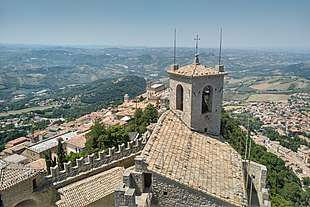Economy of San Marino
The economy of San Marino is focused around industries such as banking, wearing apparel, including fabrics, electronics, ceramics, tiles, furniture, paints, and spirits/wines. In addition, San Marino sells collectible postage stamps to philatelists. The main agricultural products are wine and cheeses.
 | |
| Currency | Euro (EUR, €) |
|---|---|
Country group | |
| Statistics | |
| Population | |
| GDP | |
GDP growth |
|
GDP per capita | |
| 1.532% (2018 est.)[4] | |
Overview
The per capita level of output and standard of living are comparable to those of Italy, which supplies much of its food. In addition, San Marino has a state budget surplus and no national debt. Income taxes are much lower than in Italy, and there are therefore extremely strict requirements to obtain citizenship. San Marino's per capita gross national product in 2000 stood at $32,000 with more than 50% of that coming from the tourism industry which draws about 3.15 million people annually.[5]
Coins and stamps
One of the greatest sources of income from tourism comes from the sale of historic coins and stamps. In 1894, San Marino issued the first commemorative stamps and since then that has been part of a large livelihood in the republic. All 10 of the Post Offices of San Marino sell these stamps and collectible coins, including "Legal Gold Tender Coins".
Traditional economic activities in San Marino were food crops, sheep farming, and stone quarrying. Today farming activities focus on grain, vines and orchards, as well as animal husbandry (cattle and swine).
References
- "World Economic Outlook Database, April 2019". IMF.org. International Monetary Fund. Retrieved 29 September 2019.
- "World Bank Country and Lending Groups". datahelpdesk.worldbank.org. World Bank. Retrieved 29 September 2019.
- "Population on 1 January". ec.europa.eu/eurostat. Eurostat. Retrieved 13 July 2020.
- "World Economic Outlook Database, October 2019". IMF.org. International Monetary Fund. Retrieved 20 October 2019.
- "San Marino". Retrieved 2015-05-26.
